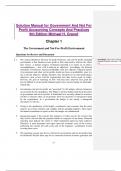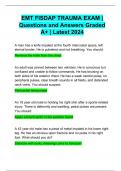Solution Manual for Government And Not For
Profit Accounting Concepts And Practices
9th Edition Michael H. Granof
Chapter 1
M
The Government and Not-For-Profit Environment
Questions for Review and Discussion
E
1. The critical distinction between for-profit businesses and not-for-profits including Formatted: Section start: Continuou
Suppress Endnotes, From text: 1.02
governments is that businesses have profit as their main motive whereas the others cm
D
have service. A primary purpose of financial reporting is to report on an entity‘s
accomplishments — how well it achieved its objectives. Accordingly, the financial
statements of businesses measure profitability, their key objective. Financial reports
of governments and other not-for-profits should not focus on profitability, since it is
G
not a relevant objective. Ideally, therefore, they should focus on other performance
objectives, such as how well the organizations met their service goals. In reality,
however, the goal of reporting on how well they have achieved such goals has
proven difficult to attain and the financial reports have focused mainly on financially-
E
related data.
2. Governments and not-for-profits are ―governed‖ by the budget, whereas businesses
E
are governed by the marketplace. The budget is the key political and fiscal document
of governments and not-for-profits. It determines how an entity obtains its resources
and how it allocates them. It encapsulates most key decisions of consequence made
by the organization. In a government the budget is not merely a managerial
K
document; it is the law.
3. Owing to the significance of the budget, constituents want assurance that the entity
achieves its revenue estimates and complies with its spending mandates. They expect
the financial statements to report on how the budget was administered.
4. Interperiod equity is the concept that taxpayers of today pay for the services that
they receive and not shift the payment burden to taxpayers of the future. Financial
reporting must indicate the extent to which interperiod equity has been achieved.
Therefore, it must determine and report upon the economic costs of the services
performed (not merely the cash costs) and of the taxpayers‘ contribution toward
covering those costs.
5. The matching concept may be less relevant for governments and not-for-profits than
for businesses because there may be no connection between revenues generated and
1-1
, the quantity, quality or cost of services performed. An increase in the demand for, or
cost of, services provided by a homeless shelter would not necessarily result in an
increase in the amount of donations that it receives. Of course, governments and not-
for-profits are concerned with measuring interperiod equity and for that purpose the
matching concept may be very relevant.
6. Governments must maintain an accounting system that assures that restricted
resources are not inadvertently expended for inappropriate purposes. Moreover,
M
statement users may need separate information on the restricted resources by
category of restriction and the unrestricted resources. In practice, these requirements
have led governments to adopt a system of ―fund‖ accounting and reporting.
7. Even governments within the same category may engage in different types of
E
activities. For example, some cities operate a school system whereas others do not.
Those that are not within the same category may have relatively little in common.
For example, a state government shares few characteristics with a city.
8.
D
If a government has the power to tax, then it has command over, and access to,
resources. Therefore, its fiscal well-being cannot be assessed merely by measuring
the assets that it ―owns.‖ For example, the fiscal condition of a city should
G
incorporate the wealth of the residents and businesses within the city, their earning
capacity, and the city‘s willingness to exploit its tax base.
9. Many governments budget on a cash or near-cash basis. However, the cash basis of
E
accounting does not provide adequate information with which to assess interperiod
equity. Financial statements that satisfy the objective of reporting on interperiod
equity may not satisfy that of reporting on budgetary compliance. Moreover,
statements that report on either interperiod equity or budgetary compliance are
E
unlikely to provide sufficient information with which to assess service efforts and
accomplishments.
10. Measures of service efforts and accomplishments are more significant in governments
K
and not-for-profits because their objectives are to provide service. By contrast, the
objective of businesses is to earn a profit. Therefore, businesses can report on their
accomplishments by reporting on their profitability. Governments and not-for-profits
must report on other measures of accomplishment.
11. The FASB influences generally accepted accounting principles of governments in
two key ways. First, FASB pronouncements are included in the GASB ―hierarchy‖ of
GAAP. FASB pronouncements that the GASB has specifically made applicable to
governments are included in the highest category; those that the GASB has not
specifically adopted are included in the lowest category. Second, the business-type
activities of governments are required (with a few exceptions) to follow the business
accounting principles as set forth by the FASB.
2-2
,12. It is more difficult to distinguish between internal and external users in governments
than in businesses because constituents, such as taxpayers, may play significant roles
in establishing policies that are often considered within the realm of managers. Also,
legislators are internal to the extent they set policy, but external insofar as the
executive branch must account to the legislative branch.
Exercises
M
EX 1-1
1. a
2. c
3. c
E
4. c
5. b
6. c
7. d
8. c
9. b
10. c
D
G
EX 1-2
E
1. b
2. b
3. d
E
4. b
5. a
6. c
7. a
K
8. b
9. a
10. b
EX 1-3
a. 1. The Governmental Accounting Standards Board (GASB) is the independent
organization that establishes and improves standards of accounting and financial reporting
for U.S. state and local governments. Established in 1984 by agreement of the Financial
Accounting Foundation (FAF) and 10 national associations of state and local government
officials, the GASB is recognized by governments, the accounting industry, and the capital
markets as the official source of generally accepted accounting principles (GAAP) for
state and local governments.
2-3
, Accounting and financial reporting standards designed for the government environment
are essential because governments are fundamentally different from for-profit businesses.
Furthermore, the information needs of the users of government financial statements are
different from the needs of the users of private company financial statements. The GASB
members and staff understand the unique characteristics of governments and the
environment in which they operate.
M
The GASB is not a government entity; instead, it is an operating component of the FAF,
which is a private sector not-for-profit entity. Funding for the GASB comes primarily from
an accounting support fee established under the Dodd-Frank Wall Street Reform and
E
Consumer Protection Act as well as the sale of certain publications. Its standards are not
federal laws or regulations and the organization does not have enforcement authority.
Compliance with GASB‘s standards, however, is enforced through the laws of some
D
individual states and through the audit process, when auditors render opinions on the
fairness of financial statement presentations in conformity with GAAP.
G
2. The mission of GASB is:
To establish and improve standards of state and local governmental accounting and
financial reporting that will:
E
Result in useful information for users of financial reports, and
Guide and educate the public, including issuers, auditors, and users of those
financial reports.
E
The mission is accomplished through a comprehensive and independent process that
encourages broad participation, objectively considers all stakeholder views, and is subject
to oversight by the Financial Accounting Foundation‘s Board of Trustees.
K
3. Based on GASB‘s White Paper, Governmental Accounting and Financial Reporting
is and Should be Different, due to the key environmental differences between
governments and for-profit business enterprises. The differing needs of the users of
governmental and business enterprise financial reports reflect the different environments in
which the organizations operate. Some of the principal environmental differences are:
Organizational Purposes. The purpose of the government is to enhance or maintain the
well-being of citizens by providing public services according to the established goals. A
government‘s financial reports should give creditors, legislative and oversight officials,
citizens, and other stakeholders the information necessary to make assessments and
decisions relevant to their interests in the government‘s accomplishment of its objectives.
In contrast, business enterprises focus on wealth creation, interacting only with those
segments of society that fulfill their mission of generating a financial return on investment
2-4






